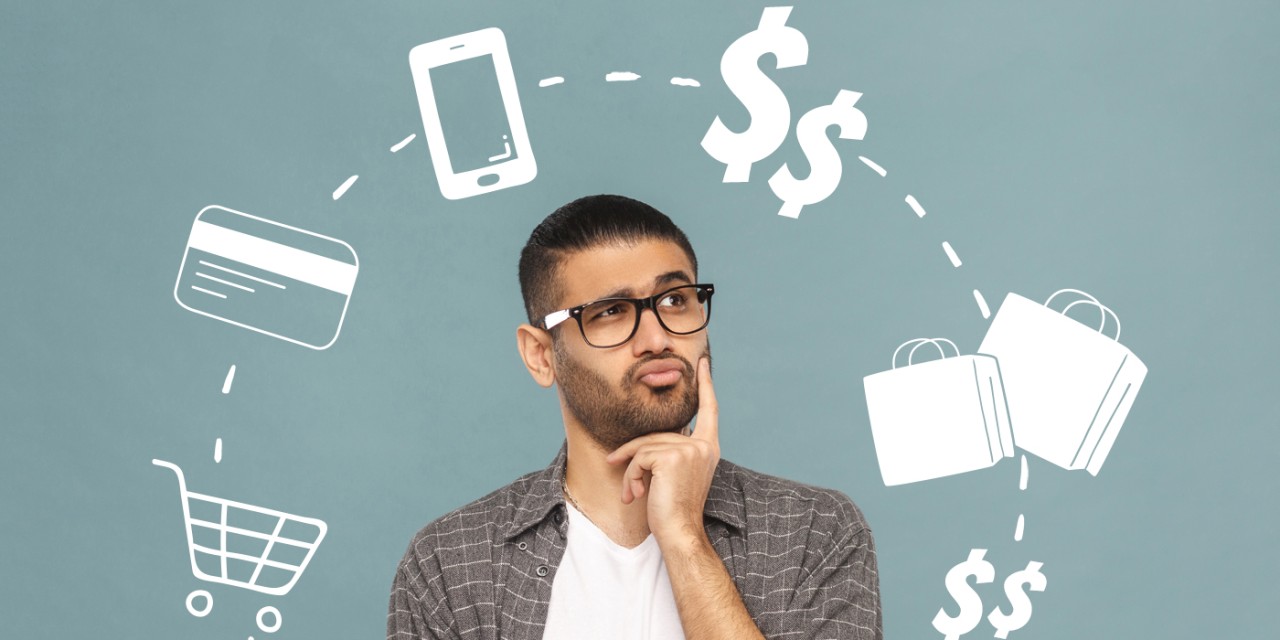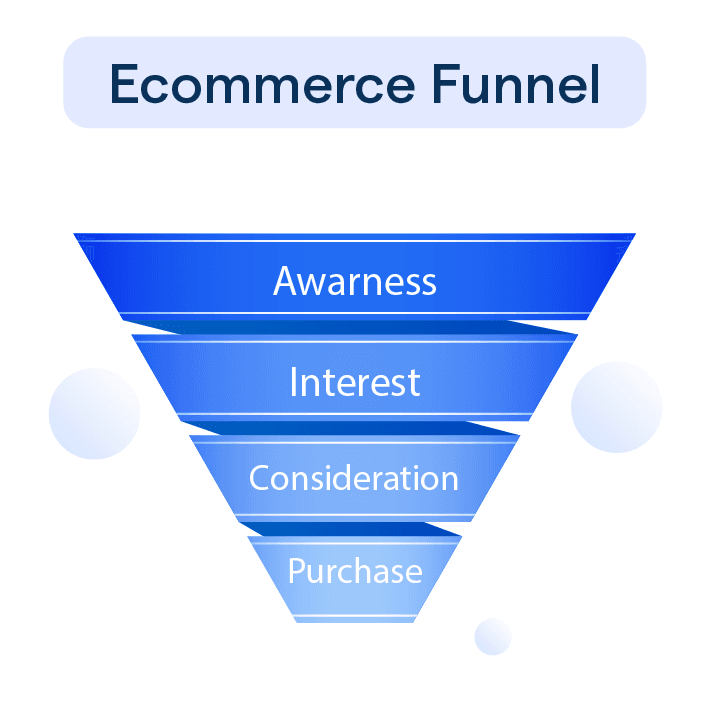What is an Ecommerce Funnel?
An ecommerce funnel is a series of stages that potential customers move through, from the moment they become aware of a product or service to the point where they make a purchase.
The funnel metaphor represents the gradual narrowing of a large number of prospects down to a smaller pool of paying customers.
Understanding and analyzing an ecommerce funnel helps online businesses optimize their websites and marketing strategies for better conversion rates, ultimately resulting in increased sales and revenue.
Why you need an E-commerce Funnel?
In this section, we'll cover the reasons why you need an ecommerce funnel for your online business.
Highlight Potential Improvements
An ecommerce funnel provides a clear visualization of the journey that customers take, from discovering your product to making a purchase. By tracking this journey, you can identify the stages where potential customers drop off, providing significant opportunities to improve your marketing strategies.
Understand your Customer's Journey
Understanding how customers move through various stages of the funnel helps you tailor your marketing and sales strategies to match your customers' needs and preferences at every stage. This could involve creating engaging content, developing personalized offers, or improving product descriptions based on your customers' behaviour.
Increase Conversion Rates

By identifying and addressing the weak spots in your ecommerce funnel, you can significantly improve conversion rates. Whether it's optimizing your landing pages, simplifying the navigation, or streamlining the checkout process, each improvement can lead to more completed purchases.
Enhance Customer Retention
A well-managed ecommerce funnel doesn't stop at conversion. It also includes strategies to keep your customers coming back. By focusing on customer relations and retention tactics, such as email marketing, re-engagement ads, or loyalty programs, you can boost repeat purchases and enhance customer loyalty.
Boost Overall Revenue
Ultimately, a well-optimized ecommerce funnel leads to increased revenue. By continuously attracting new customers, improving the buying experience, and retaining existing customers, your ecommerce funnel will maximize your profits and help your business grow sustainably.
Breaking Down the Six-Stage Ecommerce Funnel
In this section, We'll delve into each of the six stages, supplemented with examples to provide context.
Awareness

The Awareness stage involves drawing attention to your ecommerce store using different marketing tactics.
Say, for example, you run a clothing boutique online. You might use social media advertisement to promote your new collection launching soon, sparking interest in potential customers.
Interest
Once you've drawn your audience in, pique their interest with engaging content. Direct them to interactive blogs, videos, or infographics about your products. For instance, you might publish a blog post on "10 Summer Outfit Ideas" to spotlight your boutique's latest collection.
Consideration

Now, potential customers are considering their options. Offering information like detailed product descriptions, customer reviews, FAQs, and comparison charts can aid their decision-making process. If they're torn between two dresses in your store, a side-by-side comparison can push them toward making a choice.
Purchase
At this stage, customers are ready to buy. Simplify their experience with a seamless checkout process and multiple payment options. For example, offer checkout options like "Buy Now" or "Add to Cart," and accommodate different payment methods such as credit cards, PayPal, and Apple Pay.
Retention
Congratulations, you've made a sale! But your job isn't over yet. Retention involves nurturing an ongoing relationship with your customers. Send thank you emails, offer discount codes for their next purchase, or invite them to join a customer loyalty program to encourage repeat purchases.
Advocacy
Finally, transform your customers into brand advocates. Solicit their reviews for your store and the products they've purchased. Encourage them to share these reviews or refer friends by offering incentives, such as affiliate commissions or discount codes.
Hence, from awareness to advocacy, each stage of the ecommerce funnel plays a key role in driving traffic, generating sales, and building customer loyalty.
Optimizing your Ecommerce Conversion Funnel
In this section, we'll explore various strategies to boost conversions through optimization of your ecommerce funnel.
Improve Product Discovery
Enhance your customers' shopping experience by making it easy for them to find the products they're looking for. This could involve using accurate product categories, enabling advanced search options, showcasing bestsellers, or offering personalized product recommendations based on browsing history.
Optimize Product Pages
It's important to ensure that your product pages sufficiently detail the features, benefits, and specifications of your items. Clear and enticing visuals, compelling product descriptions, and customer reviews can significantly impact the decision-making process of potential buyers.
Simplify the Checkout Process
A lengthy or complicated checkout process may result in cart abandonment. Keep this process simple and transparent, providing multiple payment options, clear shipping and return information, and an option for guest checkout.
Leverage Retargeting Strategies
If prospective customers leave your site without purchasing, you can still recover these potential sales through retargeting strategies. This could involve email reminders of left-behind cart items, capturing customer information via exit-intent pop-ups, or display ads on social media platforms.
Prioritize Post-Purchase Engagement
Your relationship with a customer doesn't end at the point of sale. After-purchase engagement, including offering discounts on future purchases, sending personalized product recommendations, or providing excellent customer service, can boost customer loyalty and encourage repeat purchases.
Types of E-commerce Conversion Funnels
While the six-stage ecommerce funnel we've discussed is the most common, there are other types of ecommerce conversion funnels that businesses can adopt, depending on their goals, audience, and offerings.
In this section, we'll delve into various types of ecommerce conversion funnels which can significantly enhance your online store strategy.
Awareness Stage Funnels
The 'Awareness Stage' funnel attracts potential customers who are learning about your products or services. Powerful content marketing, SEO, and social media strategies play a part in creating brand awareness and drawing traffic to your website.
Consideration Stage Funnels
In the 'Consideration Stage', potential customers are evaluating their options. Email marketing, retargeting campaigns, and persuasive landing pages play a vital role to keep prospects engaged and guide them to the next stage.
Decision Stage Funnels
In the 'Decision Stage', customers are ready to make a purchase. At this point, compelling product descriptions, convincing customer testimonials, and clear calls-to-action can tip the scale in your favor.
Cart Abandonment Funnels
'Cart Abandonment' funnels kick in when potential customers abandon their shopping carts before making a purchase. Implementing measures like cart abandonment emails or offering exclusive discounts can coax these potential customers back to complete their purchase.
Post-Purchase Funnels
'Post-purchase' funnels ensure that the relationship with the customer does not end post-purchase. Sending personalized follow-up emails, requests for reviews, or offers for complementary products can enhance customer loyalty.
Retention and Advocacy Funnels
'Retention and Advocacy' funnels aim to transform customers into brand advocates. Stellar customer service, loyalty reward programs, and referral incentives can turn happy customers into powerful, word-of-mouth marketers for your brand.
Frequently Asked Questions (FAQs)

What is an ecommerce funnel?
An ecommerce funnel refers to the step-by-step process that guides a user from awareness to making a purchase on an online store. It includes stages like discovery, consideration, and conversion.
How does the awareness stage work?
In the awareness stage of an ecommerce funnel, potential customers become aware of your brand and products through advertising, social media, or word-of-mouth. The goal here is to generate interest and attract their attention.
What happens during the consideration stage?
Once users are aware of your brand, they enter the consideration stage. Here, they evaluate your products, compare prices, read reviews, and weigh their options. It's important to showcase the value and benefits of your offerings at this stage.
What does the conversion stage involve?
The conversion stage is where users take the desired action, such as making a purchase or completing a form. It's crucial to have a seamless checkout process, effective call-to-actions, and clear product information to convert users into paying customers.
What is the role of retention in an ecommerce funnel?
Retention refers to the ability to keep customers engaged and satisfied after their initial purchase. This stage involves strategies like post-purchase follow-ups, providing excellent customer support, and nurturing long-term relationships to encourage repeat purchases and loyalty.

